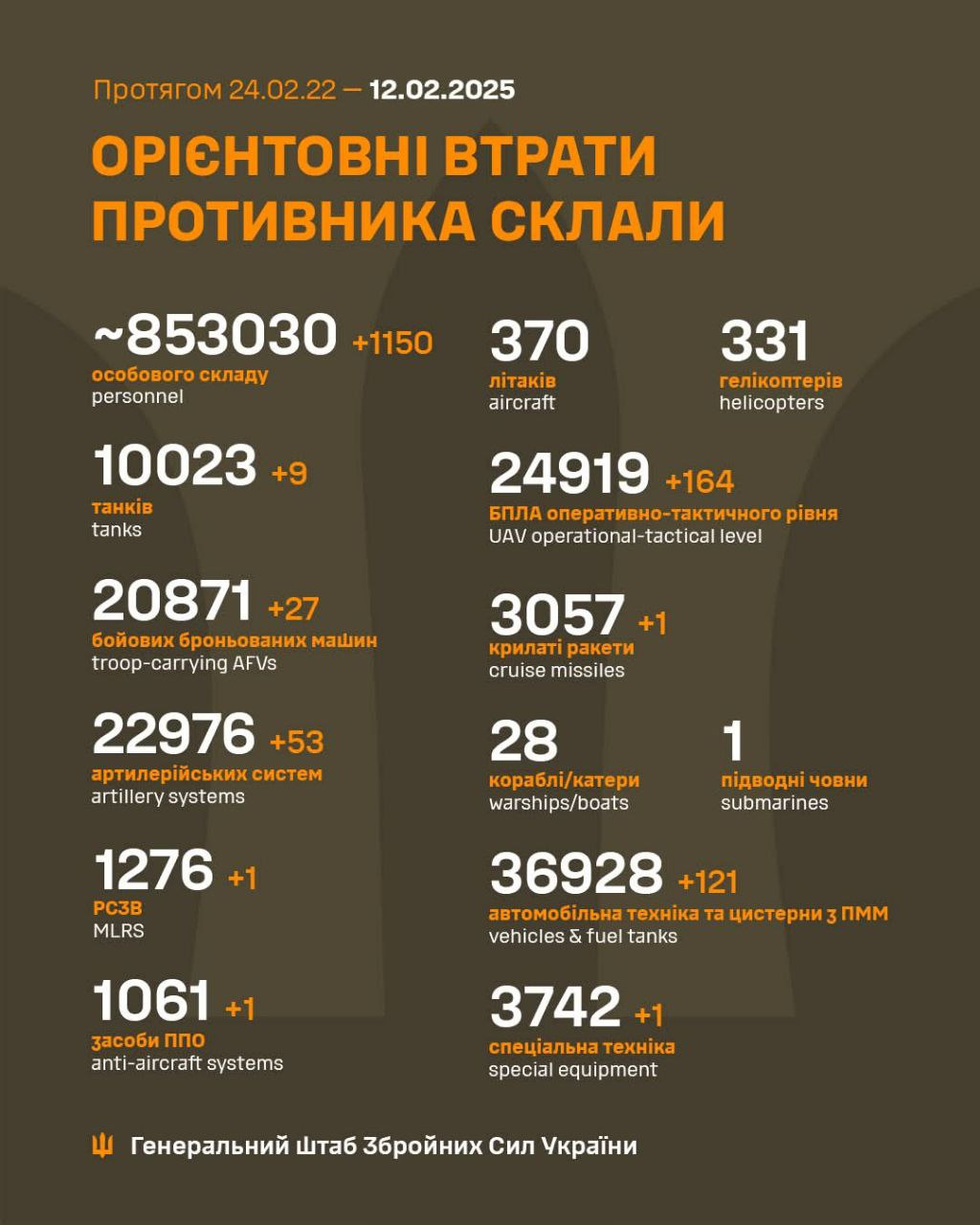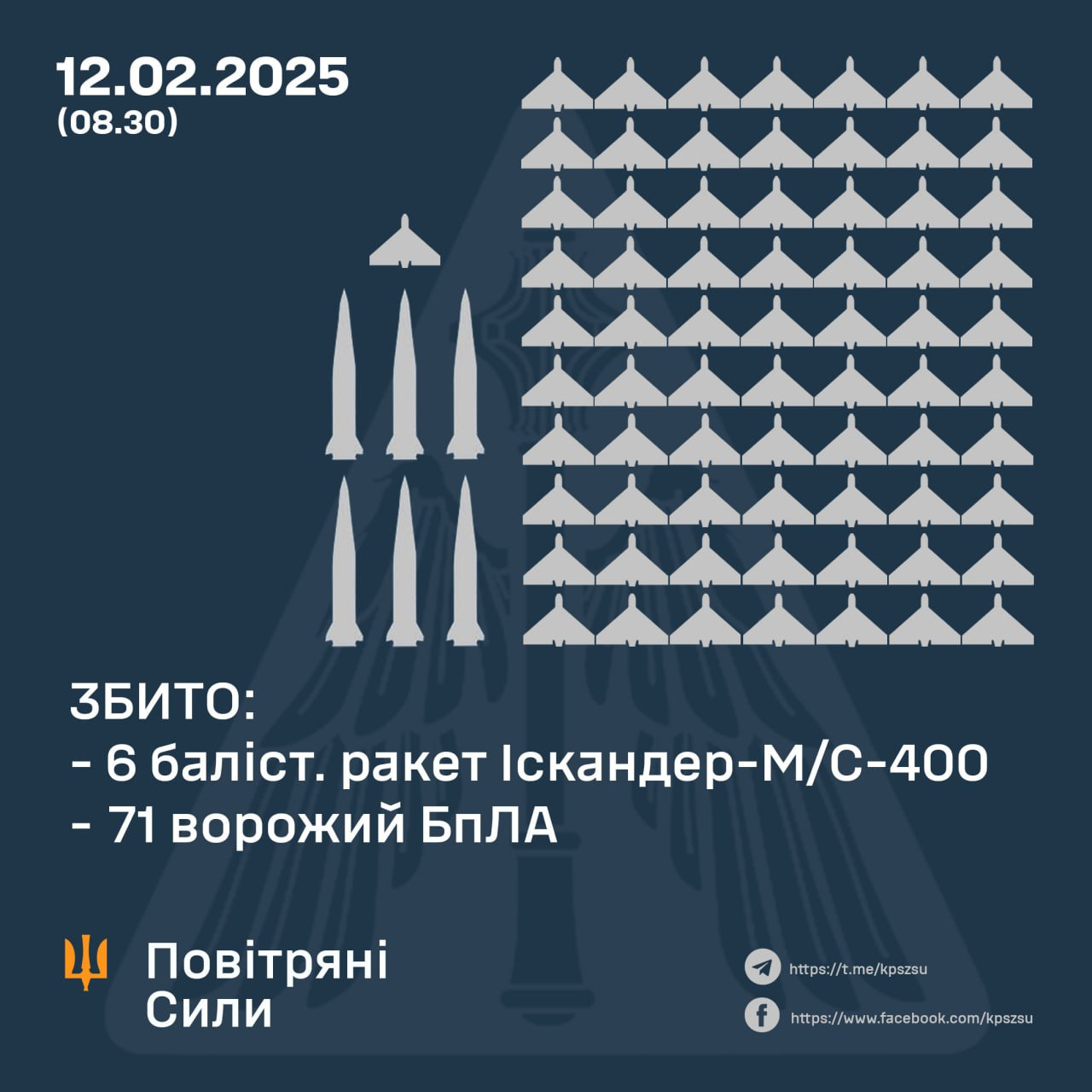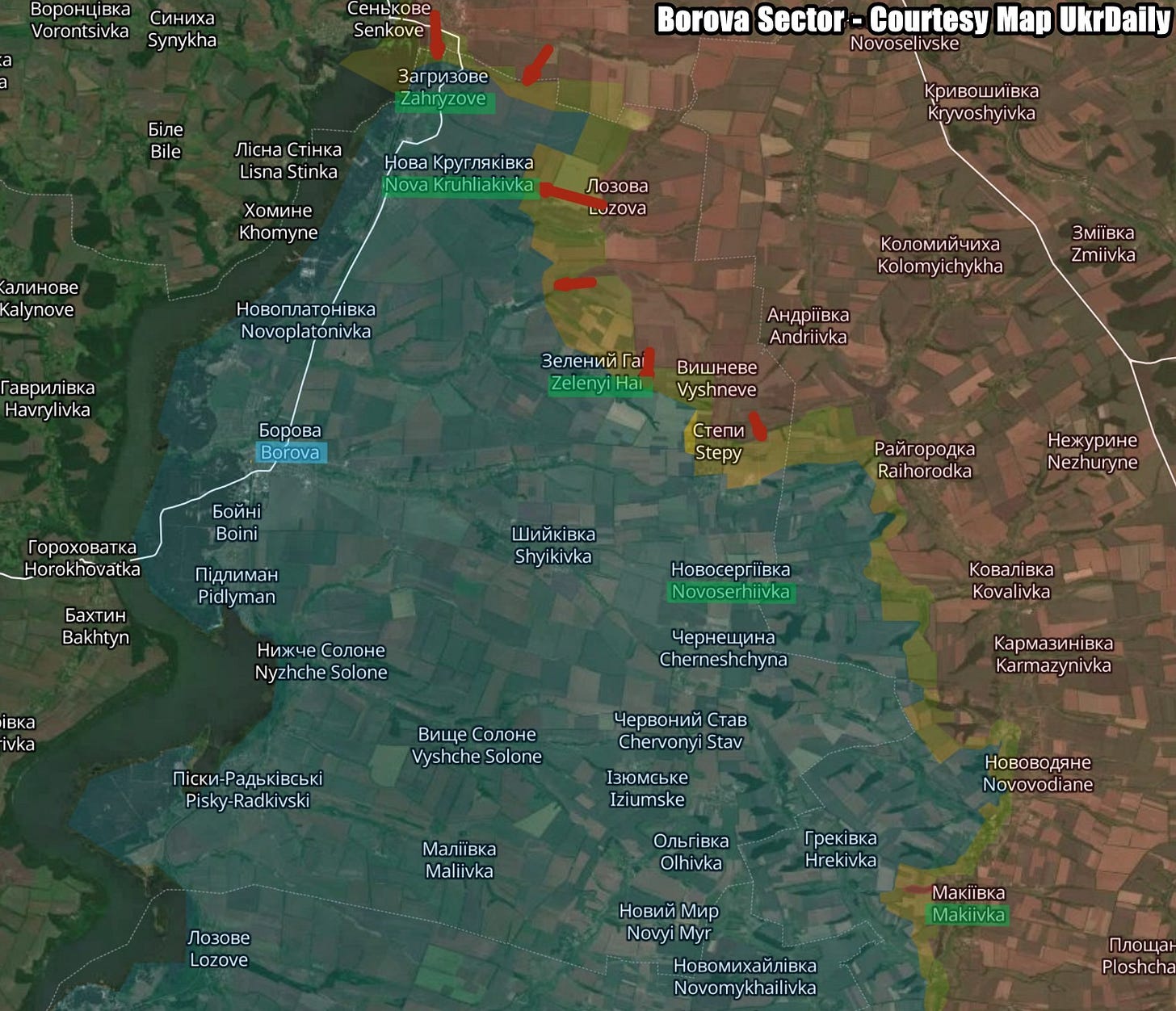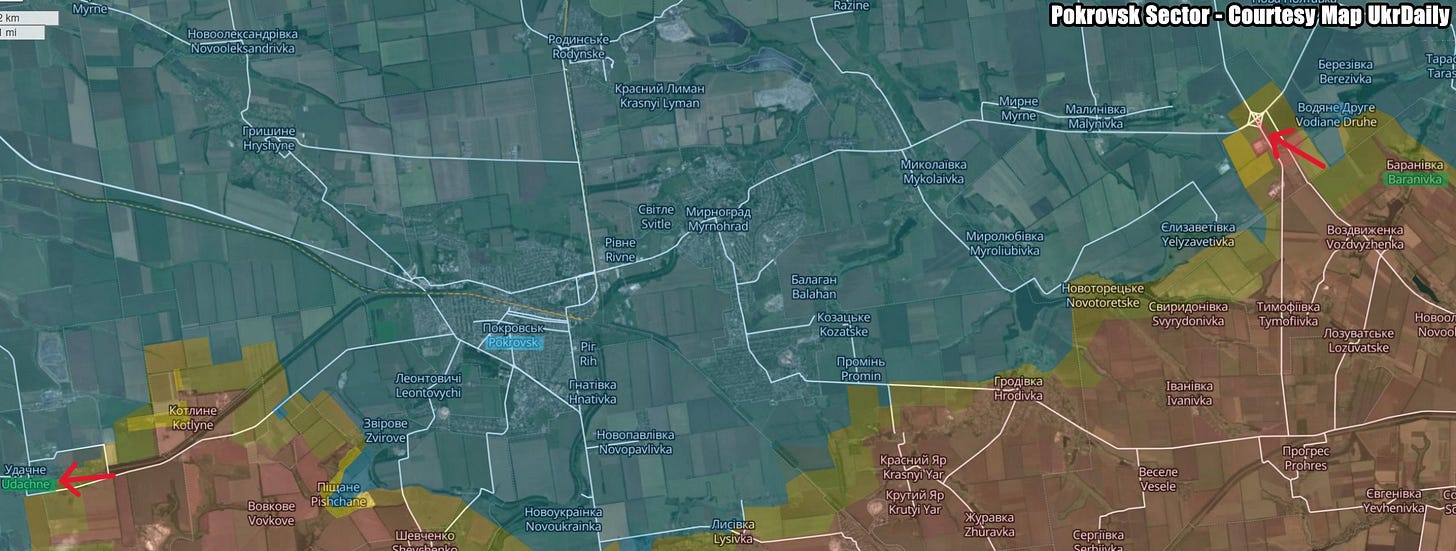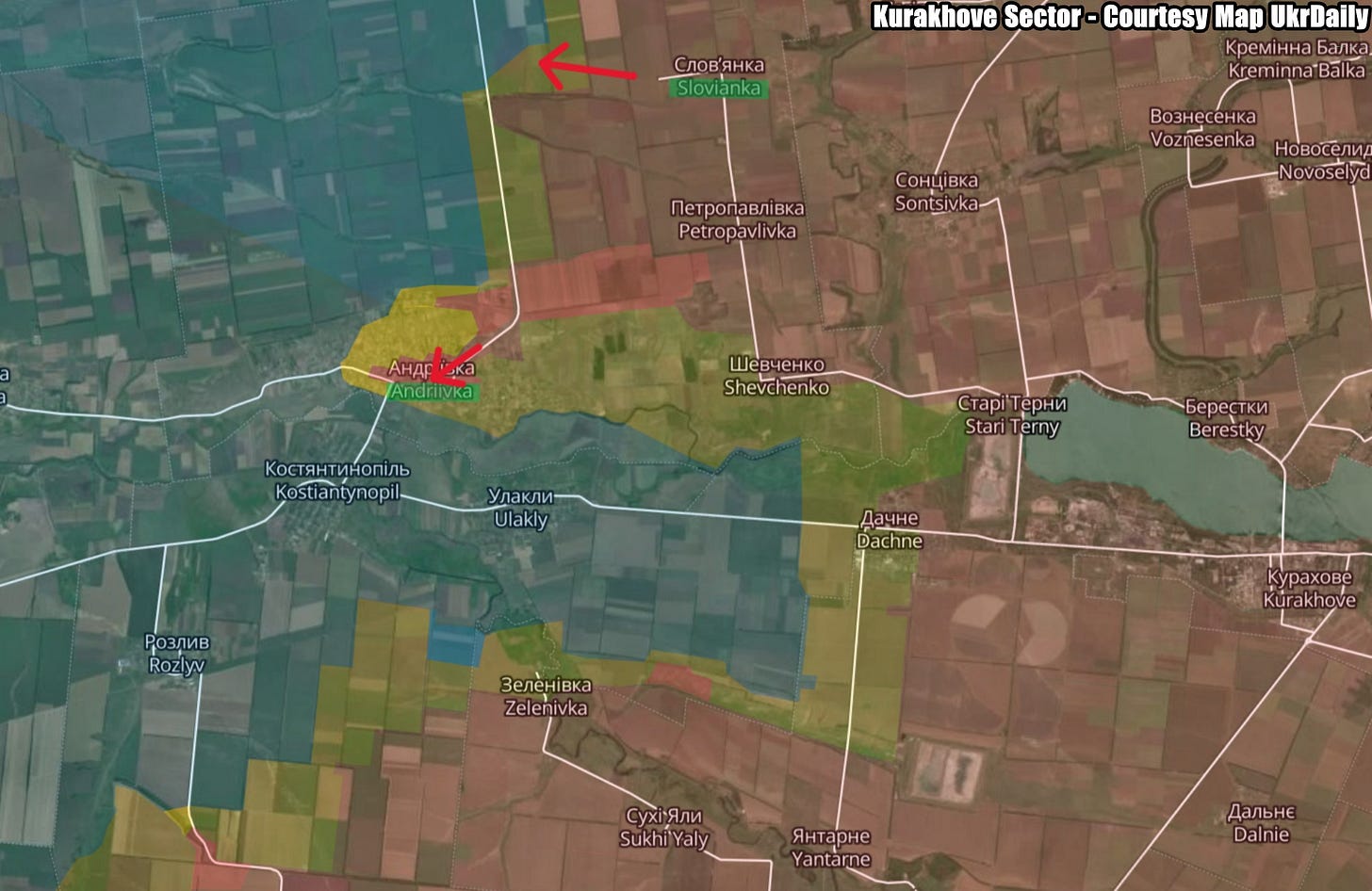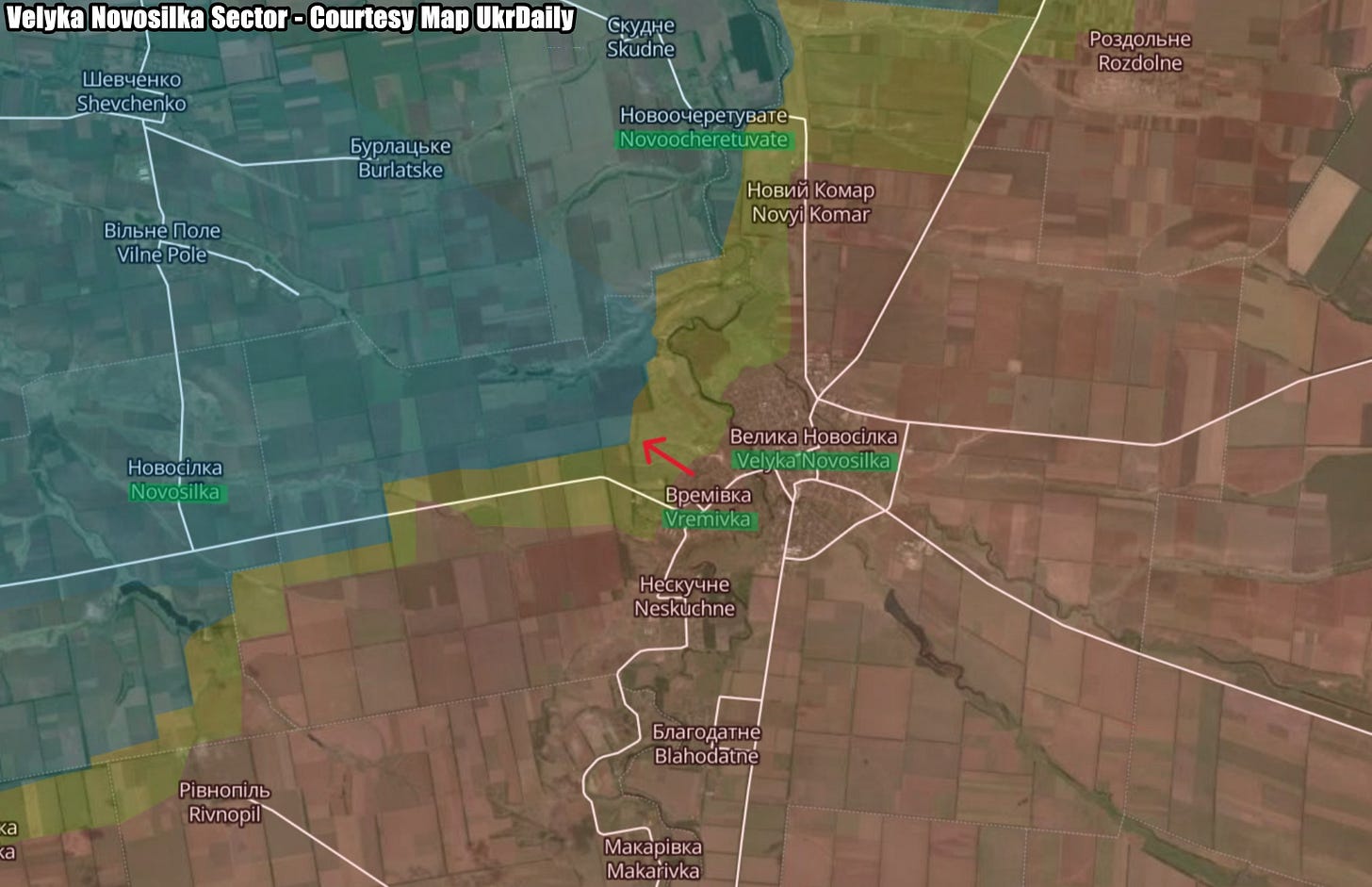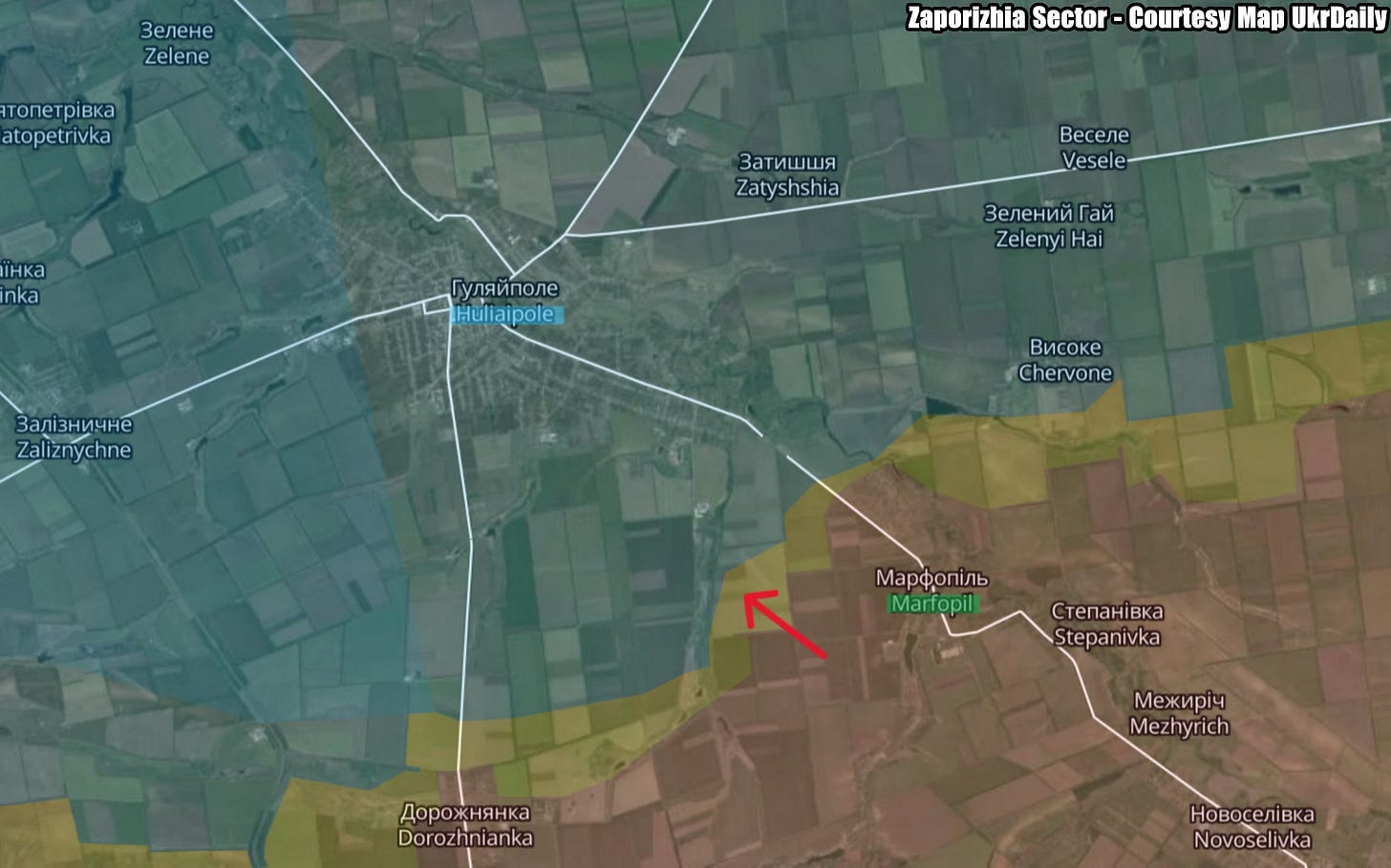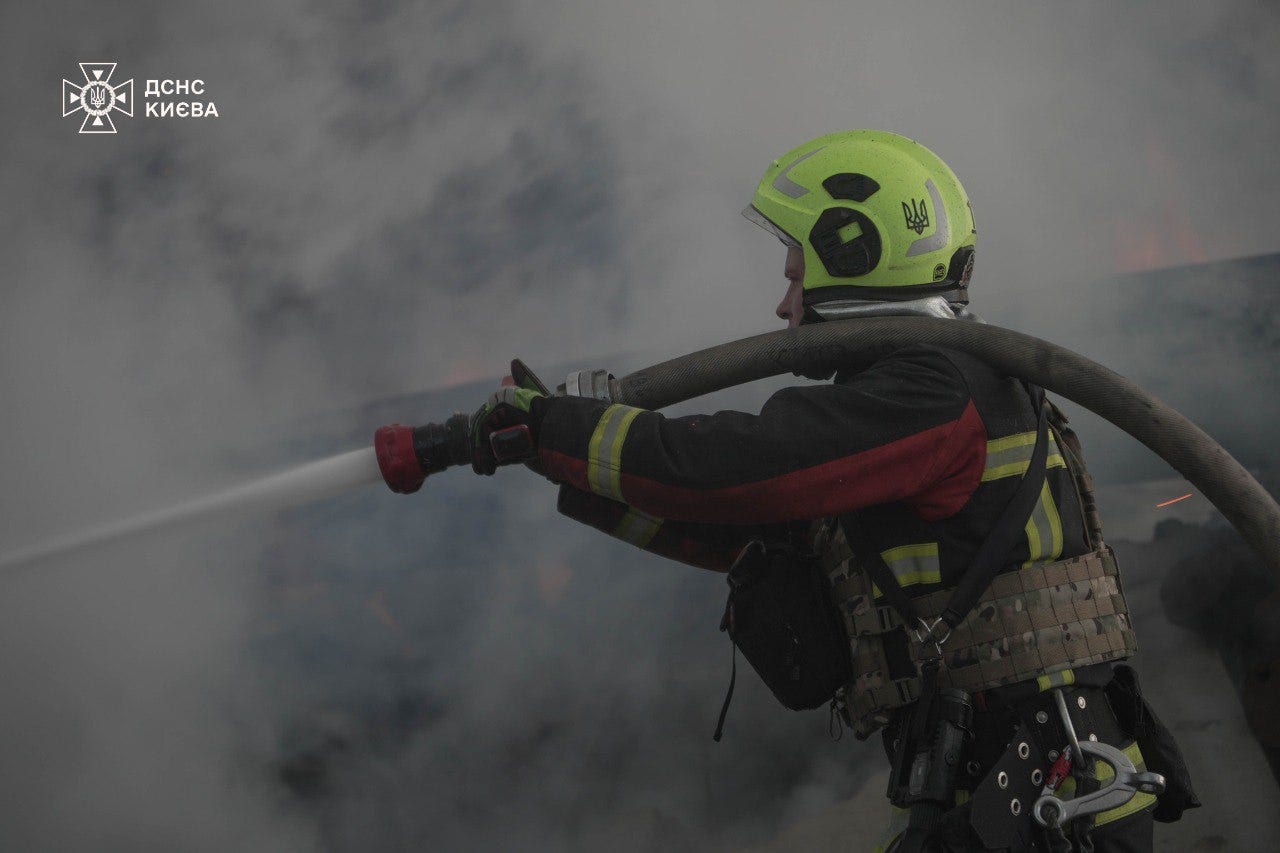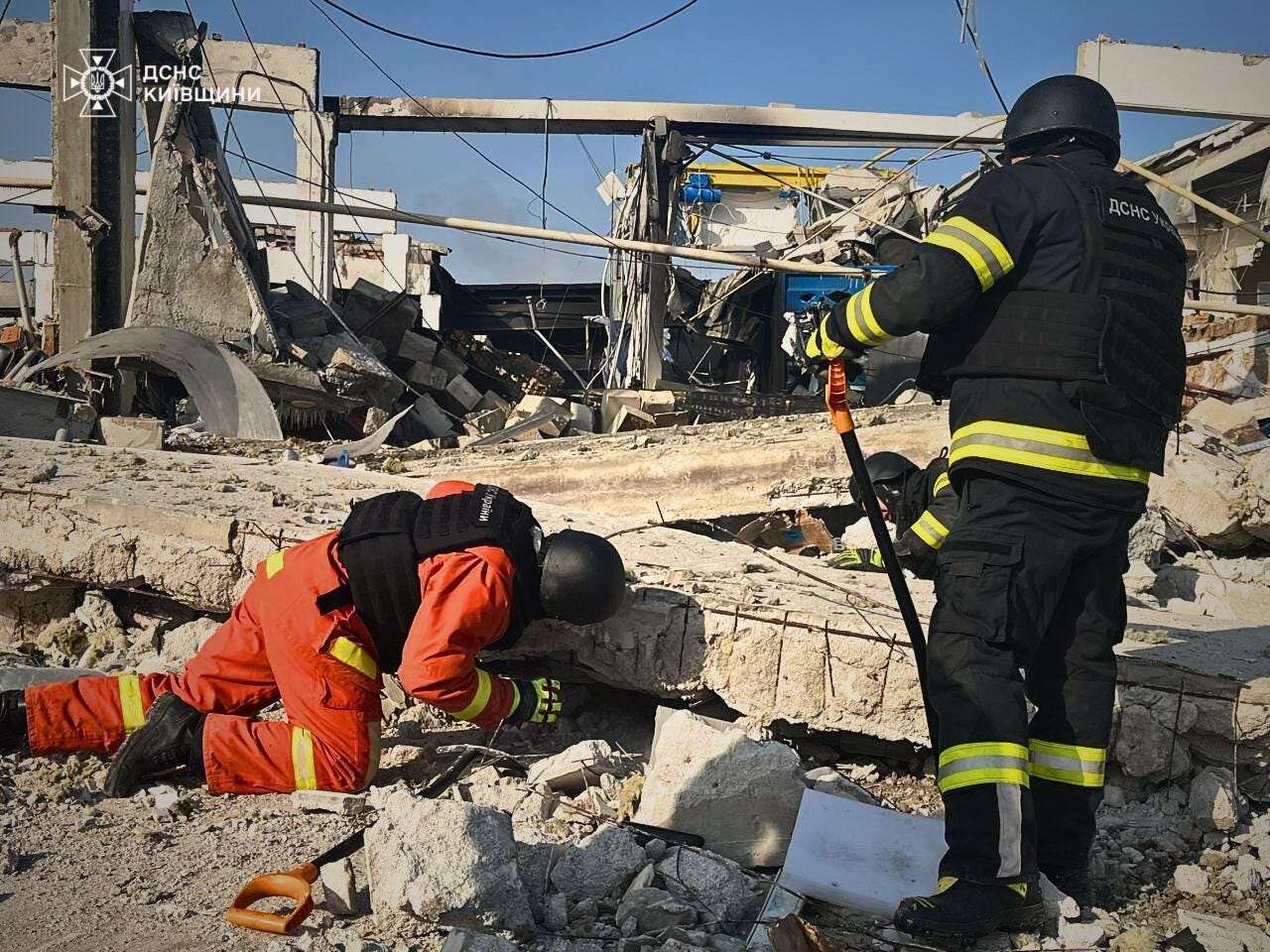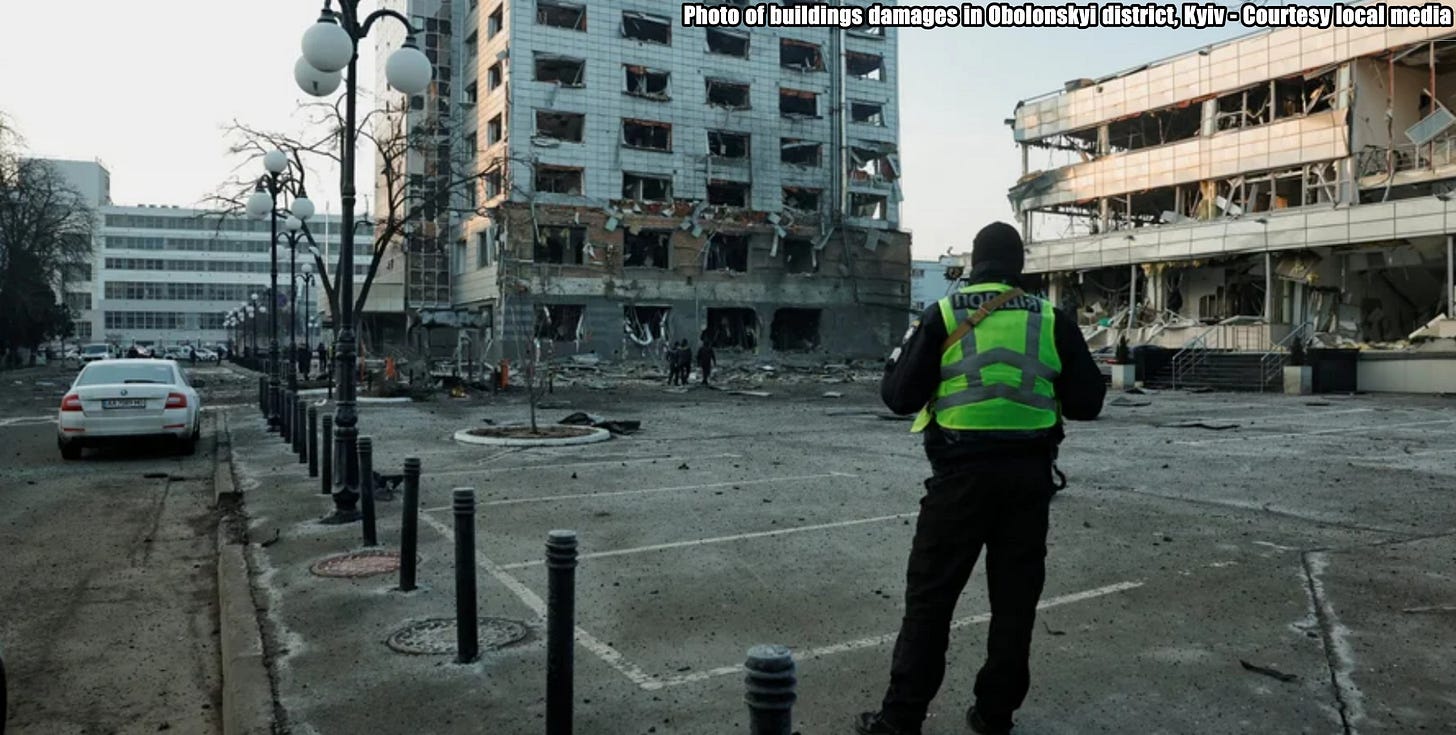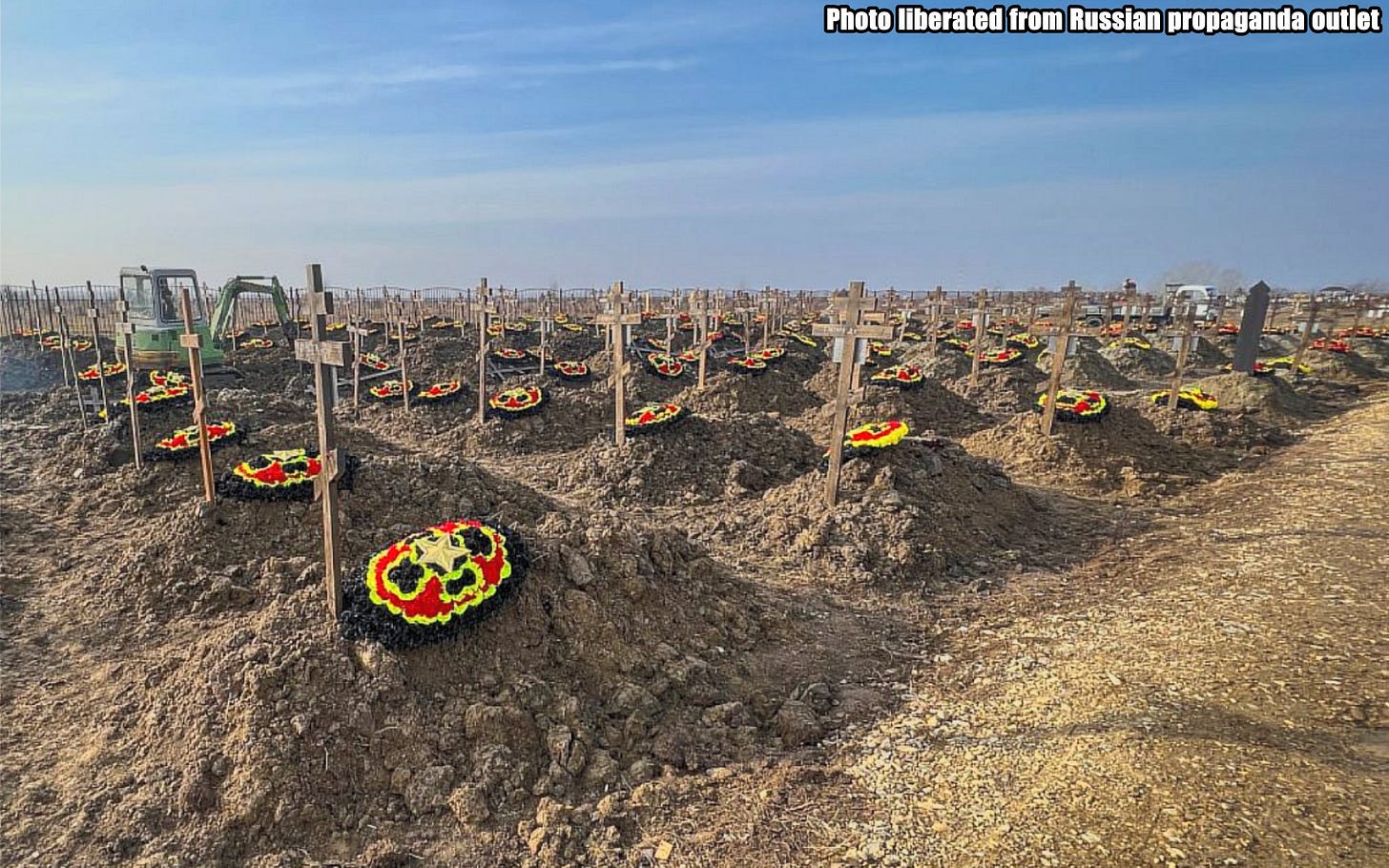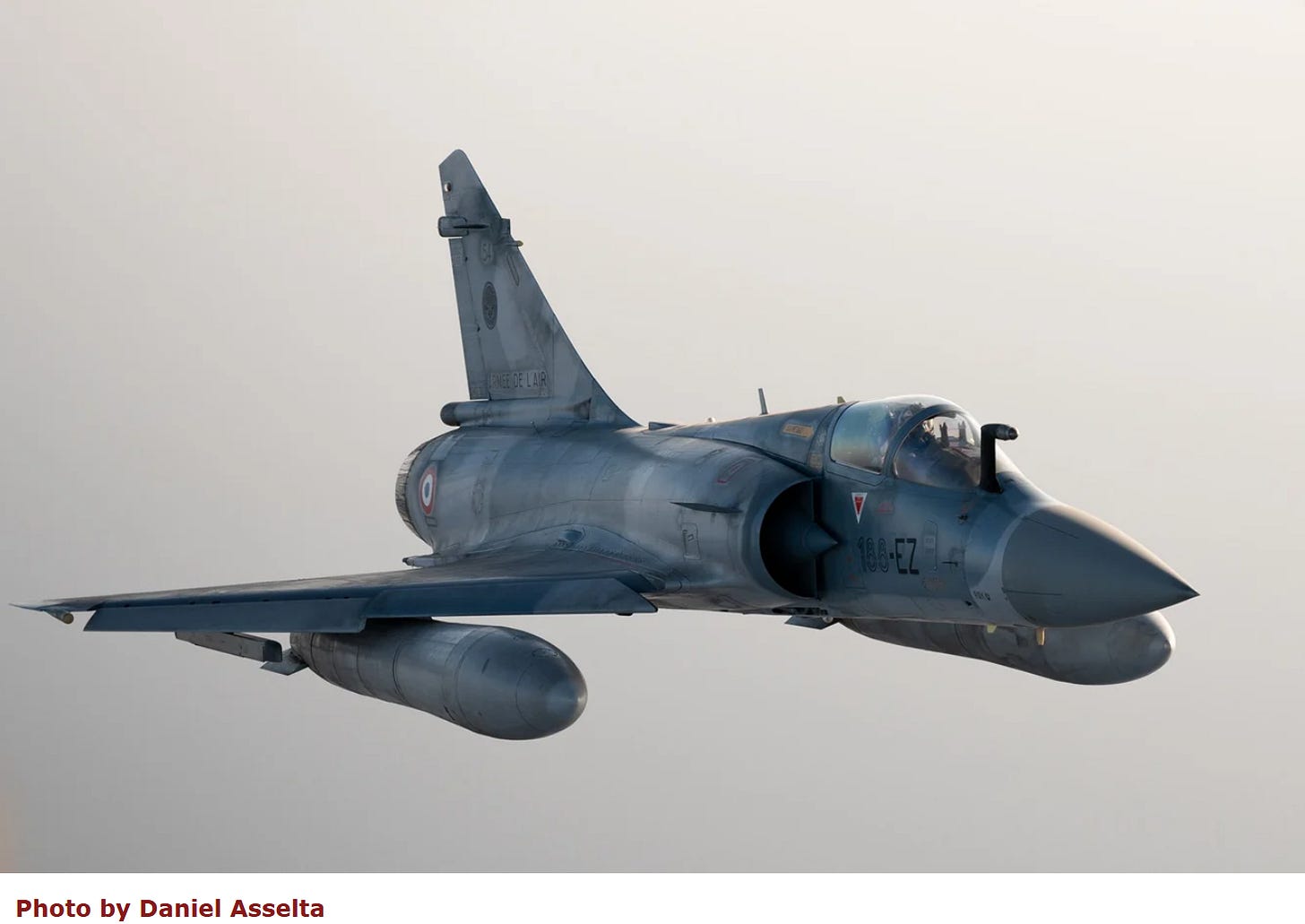Slava Ukraini! In early 2022 I began a Telegram channel aggregating news from a number of sources daily on the war in Ukraine. In June 2023 I began providing a daily draft for the Ukraine War Brief Podcast collecting news from over 70 sources daily, which formed the basis of the script. While the Podcast no longer exists I have continued to make this Brief available for my followers here on Substack for those who wish to keep up with the news from the war.
All the latest news on the Russo-Ukraine War 6 days per week
ALONG THE CONTACT LINE
GSAFU Morning Report
The General Staff of the Armed Forces of Ukraine in its Operational Information update at 08:00 on Feb 12 stated that day 1084 of the full-scale invasion of the Russian Federation against Ukraine had begun.
The situation on the line of combat remains tense in some sectors. Ukrainian defenders continue to actively counteract the Russian aggressor, causing them significant losses in personnel, equipment and technology. Exhausting the enemy along the entire front line and continuing to disrupt the plans of Russian occupiers to advance deeper into the territory of Ukraine.
During the past day, 95 combat engagements took place.
Over the past 24 hours, the enemy carried out 3 missile strikes, 89 air strikes, used 2,354 drones and fired approximately 6,300 artillery shells across the positions of Ukrainian forces and civilians.
Air Force Daily Report
On the night of February 12, 2025 (from 19:00 on February 11), the enemy launched a strike with Iskander-M ballistic missiles (S-400 anti-aircraft guided missiles) on Kyiv and Kryvyi Rih. Six launches were carried out from the Bryansk region and one from Crimea.
The enemy also attacked with 123 Shahed attack UAVs and other types of simulator drones from the following directions: Millerovo, Orel, Bryansk, Kursk, Primorsko-Akhtarsk — Russia.
Aviation, anti-aircraft missile units, electronic warfare equipment, and mobile fire groups of the Air Force and Defense Forces of Ukraine were involved in repelling the enemy air attack.
As of 08:30, the downing of six Iskander-M ballistic missiles (S-400 missile defense system) and the 71st Shahed attack UAV (other types of drones) was confirmed in Kharkiv, Poltava, Sumy, Kyiv, Cherkasy, Chernihiv, Kirovohrad, Zhytomyr, Dnipropetrovsk, Kherson and Mykolaiv regions.
40 enemy drone simulators were lost in location (without negative consequences).
As a result of the enemy attack, the Kyiv region, Dnipropetrovsk region (Kryvyi Rih), Sumy region, Poltava region, and Chernihiv region suffered.
Combat Operations in the Kursk Sector, Russian Federation
The Institute for the Study of War (ISW), a US based think tank, in its Feb 11 Russian Offensive Campaign Assessment reported that Fighting continued in the Ukrainian salient in Kursk Oblast on Feb 11 but made no confirmed advances. A Russian milblogger claimed that fighting continues northwest of Sudzha near Pogrebki; west of Sudzha near Sverdlikovo; southeast of Sudzha near Makhnovka, Cherkasskaya Konopelka, and Fanaseyevka.
Russian milbloggers claimed that Ukrainian forces unsuccessfully attacked near Russkoye Porechnoye (north of Sudzha) and Cherkasskaya Konopelka.
The Khortytsia operational-strategic group
(Responsible for the northeastern part of Ukraine. )
Borova Sector: Russian forces recently advanced in the Borova direction on Feb 11. Russian forces continued ground attacks northeast of Borova near Zahryzove and Nova Kruhlyakivka; east of Borova near Zeleny Hai, Novoyehoriivka, and Kopanky; and southeast of Borova near Novoserhiivka on Feb 10 and 11. A milblogger claimed that Ukrainian forces counterattacked near Zahryzove.
The Ukrainian General Staff published a map on Feb 11 indicating that Russian forces likely recently advanced in fields north of Makiivka (southeast of Borova).
Lyman Sector: Russian forces recently advanced in the Lyman direction. Russian forces continued offensive operations northeast of Lyman near Novolyubivka, Kolodyazi, Yampolivka, Ivanivka and Terny on Feb 10 and 11.
Assessed Russian advances: The Ukrainian General Staff published a map on Feb 11 indicating that Russian forces likely advanced in fields northwest of Ivanivka.
Toretsk Sector: Ukrainian and Russian forces recently advanced in the Toretsk direction. Russian forces conducted ground attacks within Toretsk itself, north of Toretsk near Dyliivka, and west of Toretsk near Shcherbynivka on Feb 10 and 11.
Assessed Ukrainian advances: Geolocated footage published on Feb 10 and 11 indicates that Ukrainian forces recently advanced northeast of Druzhba, in northern Toretsk, and in central Leonidivka (west of Toretsk).
Assessed Russian advances: Geolocated footage published on Feb 10 indicates that Russian forces marginally advanced in western Toretsk.
The Tavria operational-strategic group
(Responsible for the central-eastern and southeastern part of Ukraine.)
Pokrovsk Sector : Russian forces recently advanced in the Pokrovsk direction. Russian forces continued attacking northeast of Pokrovsk near Vodyane Druhe and Berezivka; east of Pokrovsk near Yelyzavetivka, Promin, Baranivka, Myrolyubivka, Zelene Pole, and Tarasivka; southeast of Pokrovsk near Lysivka; south of Pokrovsk near Zvirove, Shevchenko and Dachenske; and southwest of Pokrovsk near Kotlyne, Udachne, Nadiivka, Uspenivka, Preobrazhenka, Zaporizhzhia, Novooleksandriivka, Sribne, and Molodetske on Feb 10 and 11.
Ukrainian military observer Kostyantyn Mashovets stated on Feb 11 that Russian forces seized Baranivka. Geolocated footage published on Feb 10 indicates that Russian forces recently advanced in eastern Udachne.
Kurakhove Sector: Russian forces recently advanced in the Kurakhove direction. Russian forces continued attacking northwest of Kurakhove near Shevchenko and Andriivka; west of Kurakhove near Dachne and Kostyantynopil; and southwest of Kurakhove near Zelenivka on Feb 10 and 11.
Geolocated footage published on Feb 10 and 11 indicates that Russian forces advanced in central Andriivka and along the T-0515 Pokrovsk-Kostyantynopil highway west of Slovyanka (northwest of Kurakhove).
Velyka Novosilka Sector: Russian forces recently advanced in the Velyka Novosilka direction. Russian forces conducted ground attacks north of Velyka Novosilka in the direction of Novoocheretuvate; west of Velyka Novosilka near Vremivka and Novosilka; and northwest of Velyka Novosilka in the direction of Burlatske on Feb 10 and 11.
The Ukrainian General Staff published a map on Feb 11 indicating that Russian forces recently advanced in the fields northwest of Vremivka.
Zaporizhia Sector: Russian forces recently advanced in eastern Zaporizhia Oblast.
The Ukrainian General Staff published a map on Feb 11 indicating that Russian forces likely recently advanced in fields west of Marfopil (southeast of Hulyaipole).
The Odesa operational-strategic group
(Responsible for Kherson, Qırım, (also known as Crimea) and the Black Sea.)
There have been no major changes to the combat environment since our last report.
TEMPORARILY OCCUPIED TERRITORIES
Nothing major to report.
THE HOME FRONT
Russian ballistic missile attack on Kyiv kills 1, injures 4
Russia launched a missile attack against Kyiv on the morning of Feb. 12, killing one person and injuring four others, including a child, the Kyiv Independent reports.
Various officials reported that fires had broken out in different neighborhoods of the city.
At least one person was killed and four others injured, including a 9-year-old girl, in the Obolon district of the city after a Russian missile struck an office building, Ukraine's State Emergency Service said. At least two of the injured victims required hospitalization.
In the Holosiivskyi district, a large fire engulfed a warehouse, while in the Solomianskyi district, the roof of a residential building caught fire.
An office of the state news channels Freedom TV and Dim were damaged in the attack, the channels said in a statement, reporting no casualties.
Explosions were reported in Kyiv around 4:30 a.m. local time, according to several Kyiv Independent journalists on the ground.
Preliminary reports indicate that four Iskander ballistic missiles were launched towards the capital.
Ukraine's Air Force warned immediately prior to the attack of the threat of Russian missile attacks targeting various regions of the country. The air raid alerts were lifted about an hour later at 5:30 a.m. local time.
Damage was also reported elsewhere in Kyiv Oblast. A warehouse storing feed for animals from shelters was destroyed in Russian attacks in the region overnight, said the non-profit running the warehouse. No staff members were injured.
In recent months, Russia has continued to intensify its drone and missile attacks targeting different regions of Ukraine.
Gas-powered buildings damaged in Obolonskyi district as Russian strike hits Kyiv.
A Russian ballistic strike damaged gas-powered buildings in Kyiv’s Obolonskyi district, New Voice reported citing Kyivgaz on Feb. 12.
Facades and roofs of gas-powered buildings were damaged, and gas distribution was temporarily suspended to a preschool, a business center boiler room, and a financial institution where three boiler rooms were hit.
Early on Feb. 12, explosions rocked Kyiv as Russia launched ballistic missile attacks on the capital. According to the Kyiv Military Administration, debris from downed missiles fell in five districts — Holosiivskyi, Svyatoshynskyi, Obolonskyi, Dniprovskyi, and Pecherskyi.
Ukraine's SBU detains its counter-terrorist center chief accused of working for Russia.
The Security Service of Ukraine (SBU) has detained the head of the agency's counter-terrorism department, who is suspected of working for Russian intelligence, the Kyiv Independent reported citing SBU head Vasyl Maliuk on Feb. 12.
While the agency did not reveal the suspect's name, the Kyiv Independent's SBU sources identified him as Colonel Dmytro Koziura.
The suspect's illicit activities were documented in 14 separate cases, according to Maliuk. The SBU chief emphasized that the operation to uncover and detain him required "all possible overt and covert methods."
The case sheds light on Russian efforts to infiltrate and undermine Ukraine's security services amid the full-scale war that broke out in 2022.
"In the process, we managed to document the collection and transmission of relevant information to Russia," Maliuk added. The suspect was said to be working with Russia's Federal Security Service (FSB).
"Using encrypted software bookmarks, we penetrated the traitor's gadgets — mobile terminals and computers. We basically lived with him and conducted audio and video monitoring," the SBU chief added.
The SBU head described the operation as part of an ongoing internal purge and warned that no Russian infiltration attempts would succeed. Further details of the case are expected to be released soon.
RUSSIAN WORLD
Zelenskyy - Russia planning to boost military by 150,000 troops in 2025.
Russia intends to expand its military by 12 to 15 divisions in 2025, conscripting an additional 150,000 troops, Ukrainian President Volodymyr Zelenskyy said in an interview with The Guardian on Feb. 12.
The aggressor state will increase its military size through conscription and by recruiting North Korean soldiers, Zelenskyy added.
"Intelligence has informed me. We know," the head of state said.
“Russians will increase their army in 2025 by 12 to 15 divisions. And we estimate that this will be around 150,000 additional military personnel.”
Russia is likely to train new recruits on Belarusian soil, noted Zelenskyy.
Previously, Ukraine's First Deputy Minister of Defense, Lieutenant General Ivan Havryliuk, reported that Russia recruited at least 427,000 soldiers in 2024. This suggests a monthly increase of approximately 36,000 troops for Russia's army.
Grumpy Here - The U.S.-based Institute for the Study of War reported on Feb. 4 that Russia is likely facing difficulties in recruiting enough new soldiers to expand its forces in any meaningful way, as the monthly conscription rate is equal to or lower than the number of losses in Ukraine.
Moscow’s manpower tactics: cars and infantry over tanks.
Analysts tracking the war in Ukraine report that Russian forces are increasingly relying on lighter vehicles for battlefield maneuverability to preserve their dwindling armored assets. Defence Blog reports.
The shift comes as Ukraine’s Armed Forces continue to inflict heavy losses on Russian tanks and other armored combat vehicles, leading to adaptations in Russian assault tactics.
Since the full-scale invasion began, Ukraine has destroyed or damaged approximately 100,000 pieces of Russian military equipment, spanning land, air, and naval assets. Despite these heavy losses, Russian forces continue to field a significant stockpile of weaponry, which remains a decisive factor in the ongoing war.
Military experts note that modern Russia has never sustained such catastrophic losses in any prior conflict.
According to Ukraine’s General Staff, as of January 31, Russian tank losses alone have reached 9,893 units, with an average daily destruction rate of three to ten tanks.
The open-source intelligence website Oryx, which independently verifies military equipment losses, reports that Russian forces have lost a total of 11,786 armored combat vehicles, including tanks, armored fighting vehicles (AFVs), infantry fighting vehicles (IFVs), armored personnel carriers (APCs), and mine-resistant ambush-protected vehicles (MRAPs). Of these, 8,903 have been confirmed destroyed, 368 damaged, 979 abandoned, and 1,536 captured by Ukrainian forces.
In response to these mounting losses, Russian troops are increasingly conducting assaults using civilian vehicles, ranging from passenger cars to dune buggies and even golf carts.
According to the Ukrainian military news outlet ArmyInform, this shift in tactics reflects Russia’s struggle to maintain its supply of armored vehicles. Lighter transport options, however, expose Russian personnel to greater risks, particularly in mine-laden areas, where small, unarmored vehicles provide little to no protection against explosive devices.
INTERNATIONAL NEWS
Europe to take the helm in Ramstein as US abandons it’s role.
The U.K. is set to gather the Ukraine Defense Contact Group on Feb. 12, taking over the role the U.S. had assumed at the start of the all-out war, the Kyiv Independent reports.
With U.S. President Donald Trump pulling his country out of established international agreements and formats, it's now up to European countries to fill in the gaps.
"Now, it will be mostly the Europeans who will determine the volume and range of weapons they are willing to provide to Ukraine," lawmaker Yehor Cherniev told the Kyiv Independent.
Cherniev, who chairs Ukraine's delegation at the NATO Parliamentary Assembly, said that European nations would likely focus on supplying their self-produced weapons and ammunition to Ukraine.
"The U.S. will continue to provide us with assistance, but the main burden will now be shifted to Europe," Cherniev said. "The U.K.'s presidency in the Ramstein format symbolizes the changes in support for Ukraine that will take place in 2025."
The U.K. Joint Delegation to NATO said last week that Defense Secretary John Healey will chair the upcoming gathering of the Ukraine Defense Contact Group (UDCG), also known as the Ramstein meeting, in Brussels to discuss Ukraine's defense priorities.
Ukraine's pressing needs include bolstering the country's air defense, its deep-strike capabilities, and securing a steady ammunition supply, Ukraine's Ambassador to NATO Natalia Galibarenko said.
"We expect strong participation from our partners and look forward to hearing new pledges of military support," Galibarenko told the Kyiv Independent, saying that the three topics to be discussed at the Ramstein meeting are: "the situation on the battlefield, Ukraine's security needs, and the pledges made by our partners and allies."
U.S. Defense Secretary Pete Hegseth will attend the meeting in Brussels but won't be announcing new military shipments to Ukraine.
London's takeover of the meeting that gathers over 50 nations to discuss Ukraine's defense needs holds "a symbolic political meaning," according to lawmaker Oleksandr Merezhko, head of the parliament's committee on foreign policy.
He added that the meeting was to show that Europe would continue to support Kyiv no matter what happened in the U.S.
The adjustment in the regular Ramstein meetings comes as Ukraine and Europe await Trump's next moves. Uncertainty looms over whether the Ramstein meeting would even exist under Trump.
The U.S. president has claimed to have a plan to end the war in Ukraine and said he is in contact with Russian President Vladimir Putin.
Hegseth, who'll begin his European tour with the Ramstein meeting in Brussels, will stress "Trump's commitment for a diplomatic end to the war in Ukraine as quickly as possible" and Europe's boosting of security assistance to Kyiv, according to an official statement by the Pentagon.
Liana Fix, a fellow for Europe at the American think tank Council on Foreign Relations (CFR), agreed that it was already good news that Ramstein continues regardless of the change in the U.S. leadership and that Hegseth will still take part in it.
Rather than waiting for Trump's presidency, Europe should have long taken over Washington's leadership role at Ramstein and suggested a rotation system of European chairs to lift the weight, Fix said.
The Trump administration is demanding that European nations "take over the security" and assistance for Ukraine, but it should also be in Europe's interest to take the lead if it deems it as "existential" to its future, according to the expert.
"I think it was very comfortable for Europeans to rely on the U.S. leadership, and then there's also the question of who would lead Europe," Fix said, adding that "it's always a competition between the U.K., France, Germany, and Poland."
The downside, Fix explained, is that the U.S. is making less commitments because it won't be chairing the meeting, and the concern is how far London and Washington could push for more support for Ukraine — and whether the latter would even try pressuring other countries.
With Keith Kellogg, Trump's special envoy for Ukraine and Russia, saying that the president would try to create leverage for both sides to kickstart potential peace negotiations, securing more weapons and resources has become ever more important for Kyiv.
The past 25 rounds of Ramstein meetings, usually taking place at Ramstein Air Base in Germany, have helped Kyiv to receive over $145 billion in military aid from NATO countries, according to the Ukrainian Defense Ministry. The first-ever meeting was held in April 2022 and chaired by then-U.S. Defense Secretary Lloyd Austin, who was instrumental in gathering dozens of countries to discuss Ukraine's needs.
The "crucial platform for coordinating military aid" has enabled Kyiv to receive basic resources from artillery shells, armored vehicles and tanks to modern air defense systems and U.S.-made F-16 fighter jets, the Ukrainian Defense Ministry said in its January report.
The February Ramstein meeting takes place at a crucial time when Ukrainian forces lose one settlement after another in the country's eastern Donetsk Oblast amid a critical manpower shortage.
"The only way a ceasefire can be achieved is through increasing leverage on Russia, and that includes continuous weapon deliveries and continuous provision of weapons to Ukraine by the Ramstein format," Fix said.
MILITARY & TECH
Ukraine unveils top-secret underground missile plant
Ukrainian President Volodymyr Zelensky has presented a top-secret underground missile production facility to NATO Military Committee Chairman Giuseppe Cavo Dragone, revealing the development and deployment of the country’s latest unmanned self-propelled guided missile, known as the “Peklo.”
The missile, also referred to as a “drone-missile,” represents Ukraine’s expanding domestic defense industry amid its ongoing war with Russia.
The Peklo missile, capable of striking targets up to 700 kilometers away at a speed of 700 km/h, first became publicly known in December 2024 when Zelensky handed over an initial batch to the Ukrainian Armed Forces. Since then, it has demonstrated its effectiveness in real combat, targeting and disabling key Russian military and oil infrastructure facilities.
Ukraine’s Minister for Strategic Industries, Herman Smetanin, emphasized that the Peklo missile has already proven resistant to Russian electronic warfare systems. Future iterations are expected to feature enhanced warheads and upgraded guidance systems. He also confirmed that production is ramping up, with NATO financial support playing a crucial role in sustaining and expanding Ukraine’s missile and drone capabilities.
“Deep-strike drones and drone missiles are unique types of weaponry developed in Ukraine. We showed these products to Giuseppe Cavo Dragone and met with the production workers,” said Ganna Gvozdiar, Ukraine’s Deputy Minister of Strategic Industries. “We are grateful for all the support our NATO partners have been providing in these challenging times of our fight for freedom, and we appreciate the great interest in our defense industry achievements. The Ukrainian defense manufacturing industry has a lot to offer in terms of smart power solutions and is always open to cooperation to build the Arsenal of the Free World.”
The unveiling of the Peklo missile program is a significant step in Ukraine’s strategy to counter Russian military dominance and sustain pressure on critical Russian infrastructure. In recent months, Ukraine has successfully targeted multiple Russian oil refineries and storage facilities, disrupting the Kremlin’s energy sector and forcing Moscow to divert extensive resources to bolster its air defenses.
Beyond its military effectiveness, the Peklo missile underscores Ukraine’s growing self-sufficiency in arms production.
The NATO delegation’s visit signals the alliance’s keen interest in Ukraine’s technological advancements and its potential role in reinforcing European defense capabilities.
French fighters shoot down 10 Shahed drones.
French Mirage 2000-5F fighter jets have demonstrated strong performance in countering Houthi-operated Shahed-type drones while patrolling the skies over Yemen. Defence Blog reports.
The Militarnyi news agency quoted the French Air and Space Force Chief of Staff General Jérôme Bellanger who said that the aircraft successfully intercepted and destroyed approximately ten drones in recent operations.
“The Ukrainian Armed Forces have received the first Mirage 2000-5 fighters transferred by France. These jets will play a direct role in Ukraine’s defense,” General Bellanger wrote. “In the French Air and Space Force, both the Mirage 2000-5 and Rafale have recently proven their effectiveness against Shahed-type suicide drones, which Ukrainian pilots will also have to confront.”
A recently released video showcases a pilot’s perspective of a Mirage 2000-5F shooting down a Shahed drone using an MICA air-to-air missile. The footage highlights the precision and rapid response capability of the aircraft in neutralizing aerial threats.
French military operations in Yemen have included these fighter jets as part of their broader efforts to maintain regional stability. On March 9, 2024, the French Armed Forces General Staff announced that as part of Operation ASPIDES, a French frigate and accompanying fighter jets intercepted four kamikaze drones launched by Houthi rebels from Yemeni territory. The drones were reportedly targeting the multi-role frigate Alsace.
The success of the Mirage 2000-5F in these engagements further underscores its reliability as an air defense platform.
With France now supplying Ukraine with these aircraft, Ukrainian pilots will have access to a proven air defense tool against the increasing threat posed by Russian and Iranian-made drones. The Mirage 2000-5F’s success in Yemen suggests it will be a valuable asset in Ukraine’s efforts to counter the persistent drone warfare on its territory.
That’s it for today’s Brief folks if you would like to keep up with events in Ukraine daily please consider subscribing, it’s free!







